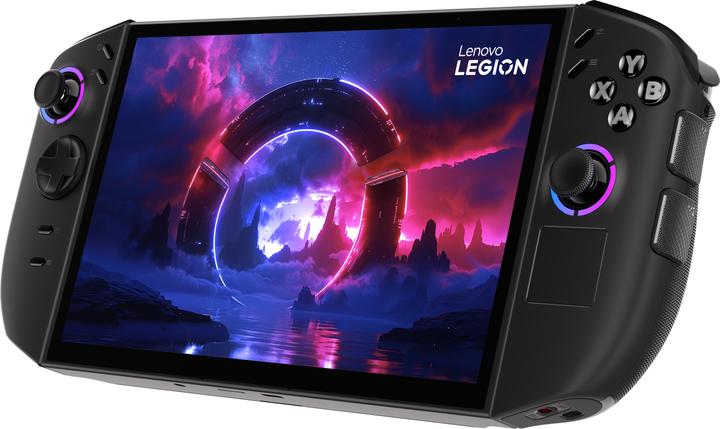
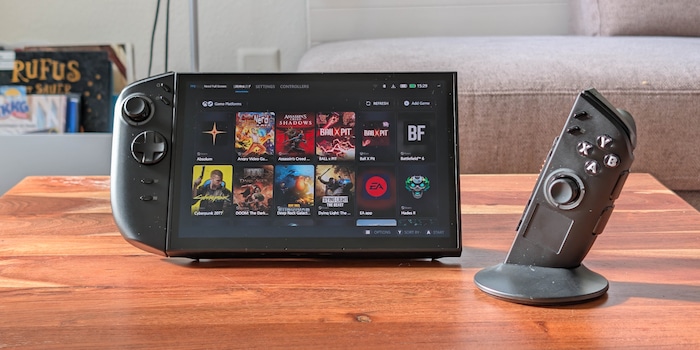
Lenovo Legion Go 2 review: too heavy, too slow
I had high hopes for Lenovo’s new premium handheld: OLED screen, fast processor, a touchpad and no more absurdly high resolution. Unfortunately, this second version of the Legion Go is still struggling with old problems.
Like the Nintendo Switch, the Legion Go 2 is a hybrid device with multiple applications. You can use it like a classic handheld or remove the controllers and switch to mouse control. The device is available in several versions, including one with the AMD Ryzen Z2 and one with the faster Ryzen Z2 Extreme. I received the latter, currently priced at almost 1,400 francs here in Switzerland, from Lenovo for testing.
A big old thing
Instead of IPS as in the first Legion Go, an 8.8-inch OLED display is used in this device. This is clearly the biggest improvement over its predecessor, but also other devices such as the Asus Rog Xbox Ally. At this size, the contrasts and strong colours really come into their own. The display has a 144 Hz refresh rate, VRR and HDR. The resolution has been reduced from an absurd 2560 × 1600 pixels to 1920 × 1200 pixels. Despite this, the image remains crisp. Even 1080p would’ve been enough. This apparent downgrade should really benefit game performance too.

The handles are more rounded and significantly more ergonomic. The device fits relatively well in my hands – I say relatively, it weighs almost a kilogram. This has a positive effect: combined with the excellent finish, it feels truly high-quality. However, at 920 grammes, it’s the second-heaviest handheld I’ve ever come across. Only the Ayaneo Kun weighs 30 grammes more.
The Steam Deck OLED weighs in at only 640 grammes. At 7.9 inches, the Switch 2 has a large display too, but still stays 534 grammes. The Legion Go 2 is only slightly larger than the Rog Xbox Ally or the Legion Go S, but at this weight, it just isn’t ergonomic. My hands cramp up much faster than with the Steam Deck. It’s not as bad as I feared, but I can’t stand it for long without supporting the device or my arms.
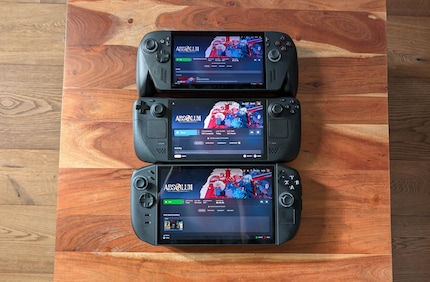
The Legion Go 2 has a foldout stand. You remove the controllers via a small button on the back, similar to the first Switch. Unfortunately, there are no magnets like on the Switch 2. Unlike Nintendo’s console, the right controller is used upright as a mouse. To do this, you insert it into the holder provided, slide the lever on the underside to FPS, then hold it with a pistol grip. That takes a lot of getting used to, yes, but the sensor is precise enough that you can play first-person shooters with the controller. I still think it’s an unnecessary gimmick that has a negative impact on costs and design.

In handheld mode, I can feel two buttons against the palm of my hand. In FPS mode, they serve as left and right mouse buttons. It doesn’t really bother me, but it’s still a bit confusing.
Buttons and sticks are a tiresome topic anyway. No handheld, whether Switch, Rog Ally or Steam Deck, ticks all my boxes. The Legion Go 2 has comfortable face buttons and a precise digital control pad. The four additional buttons on the back click comfortably and the position is perfect for my fingers. The shoulder and trigger buttons would benefit from offering a little more resistance. Same goes for the analogue sticks, which are also too thin for me. Also, the right stick is too close to the A button, so I occasionally touch it by mistake. The touchpad isn’t a revelation, but at least there is one at all, and it isn’t ridiculously small like on the Legion Go S.
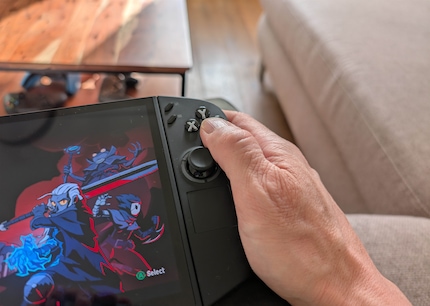
The fingerprint sensor on the upper side reacts quickly. But it could be so much further to the left, making it easier to reach. On the other hand, the volume buttons are well positioned on the top right-hand side.
Windows 11 making (sluggish) progress
Like the hardware, the software also has room for improvement. The Lenovo Legion Go 2 is a Windows handheld, coming with the usual pros and cons. You have more freedom in what you want to install than with SteamOS, but operation isn’t optimised for handhelds. Fortunately, thanks to the latest Windows update, you can activate Full Screen Experience, just like on the Asus Rog Xbox Ally. However, you’ll still have to use a workaround. This switches Windows to a more handheld-friendly mode. The Xbox app becomes your control centre, the taskbar disappears and unnecessary background processes are deactivated in favour of more performance.
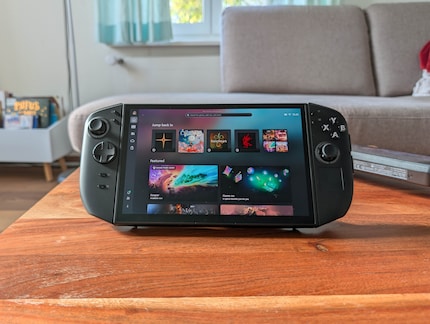
You can switch back to classic desktop mode at any time if you want to install something other than games. As I wrote in my review of the Rog Xbox Ally X, Full Screen Experience is a significant improvement over Windows 11, originally designed for desktop PCs. But it still feels unfinished. This is even more noticeable on the Legion Go 2. There, you first have to manually assign shortcuts for the task switcher, game bar and app to various buttons. Even then, the Xbox app usually only opens after I briefly activate the task switcher.

These teething problems might disappear if Lenovo officially supports Full Screen Experience. The company has told The Verge that a targeted update will be released in spring 2026. Even if it’s jankier than on the Rog Xbox Ally, I still think it’s better than the desktop version of Windows.
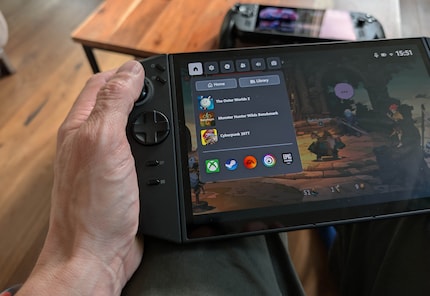
However, I’m still not convinced by the overall user experience. You’re constantly switching back and forth between different views – no consistency. In Lenovo’s Legion Space, you install updates, adjust the controls and launch games. You use the Game Bar to access the Windows settings, connect Bluetooth headphones and launch games too. With the Lenovo quick menu, you change to Performance mode, control the fans and change the resolution. I use Steam quite a bit too, because that’s where most of my games are. You can also control the Wi-Fi, Bluetooth and other settings there. It all just overlaps.
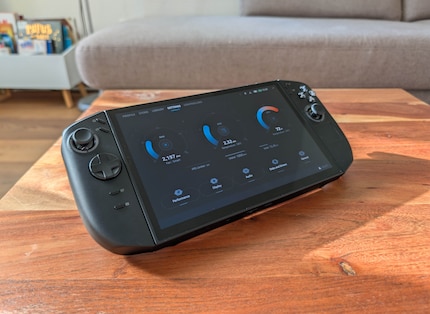
Then there are the usual problems with Windows handhelds: you can’t download a game without the device going into standby. This, in turn, is still a spin of the wheel. Sometimes your game continues running in the background, draining the battery, other times the game stops randomly. Most of the time it works fine, unfortunately it just doesn’t too often. Occasionally, nothing happens when I want to switch the device on, or I have to press several times until the device actually switches off.
Windows 11 handhelds are a permanent construction site.
I already wrote about the Rog Xbox Ally: a handheld is a toy, and toys are fun. I only get this to a limited extent with Windows. The Rog Xbox Ally is at least ergonomic and feels light as a feather compared to the monstrous Legion Go 2. Even the great features don’t change the fact that the handheld will only really feel at home in a bear’s paws.
Disappointing performance
The Legion Go 2 has 32 gigabytes of RAM and a one-terabyte SSD. Ryzen’s Z2 Extreme chip is based on the same model found in almost all gaming handhelds. The practically identical chip also powers the Asus Rog Xbox Ally X. Three performance profiles are available as standard: Quiet, Balanced and Performance. I carried out my tests with Performance.
Additionally, I tested in Full Screen Experience mode, with the latest drivers and Windows 11 25H2.
The performance is disappointing for a device with a Ryzen Z2 Extreme chip. The fps is behind the competition almost everywhere. Even the Legion Go S, which has the weaker chip, is often ahead. Only in Cyberpunk 2077 can the device clearly set itself apart. On the advice of a Reddit user, I uninstalled the graphics drivers and reinstalled them from the Lenovo site. I couldn’t detect any change this way either. Lenovo was also unable to offer me a solution when I asked them. We can only hope that future updates will release the handbrake.
Battery life record
The fans in the Legion Go 2 remain silent in games that don’t require much power. If you set the power profile to the highest level, they’re immediately noticeable, albeit very quiet. Even with more demanding titles such as Cyberpunk 2077 or The Outer Worlds 2, it takes a while for them to really become audible. I can easily play games on the sofa and watch something on the TV without my wife complaining about the noise.
The fans can’t be heard at all over the loudspeakers, which sound good in turn.
At 74 Wh, the battery has grown significantly compared to the first Legion Go. That one contains an undersized battery with 49.2 Wh. Despite its smaller screen, the Rog Ally X has a larger capacity at 80 Wh. Nevertheless, the Legion Go 2 only stops working after 140 minutes in my Cyberpunk 2077 test scenario at 1080p, maximum brightness and with the Performance profile. That’s a new record – my previous leader was the Steam Deck OLED with 130 minutes. My Rog Xbox Ally X lasted 120 minutes. The fact that the Legion Go 2 lasts longer than the Xbox Ally despite its smaller battery and larger display strengthens my suspicion that the device isn’t running at full power.
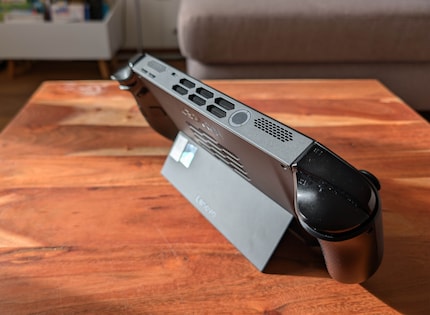
In a nutshell
Better, but far from perfect
I really thought that Lenovo would hit the big time with the Legion Go 2. Its predecessor already did a lot of things right. Unfortunately, the successor falls short of my expectations, and not just due to Windows.
When it comes to the operating system, I’m still struggling with different menus and interfaces from Lenovo, Windows and Steam, all constantly overlapping. But even if Windows were perfectly adapted to handhelds, I’d still have a few complaints about the Legion Go 2.
My main problem is with the size and weight. Sure, gaming on an almost nine-inch display is great. The device feels good, but it’s bulky and heavy. I want to have fun, not do fitness exercises – no matter how brightly the OLED with HDR shines. The price is also a hard pill to swallow. This device is way more expensive than almost all comparable handhelds.
Even the detachable controllers don’t justify this exorbitant price tag. For me, the controllers remain a marketing gimmick. Lenovo would be better off investing its development efforts in other areas. The Legion Go 2 impresses with its features, but compromises in many areas. But if you’re fine with this, you’ll still get a great device – one you’ll need strong arms for.
Pro
- Large OLED screen with HDR
- Touchpad
- Sits well in my hands
- Long-lasting battery
- Cover included
Contra
- Heavy
- Detachable controllers just a gimmick
- Slower than the competition
- Expensive

As a child, I wasn't allowed to have any consoles. It was only with the arrival of the family's 486 PC that the magical world of gaming opened up to me. Today, I'm overcompensating accordingly. Only a lack of time and money prevents me from trying out every game there is and decorating my shelf with rare retro consoles.


